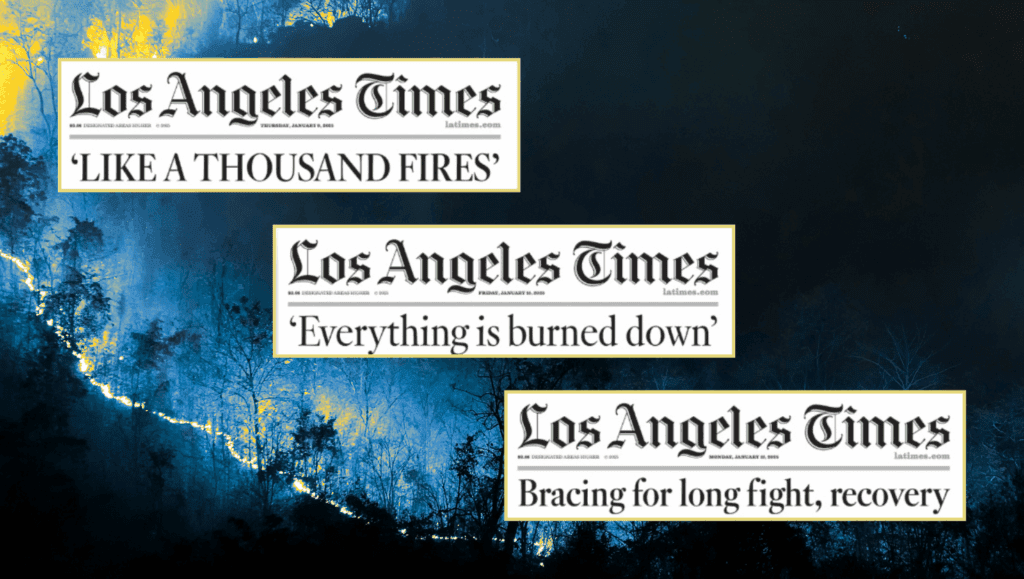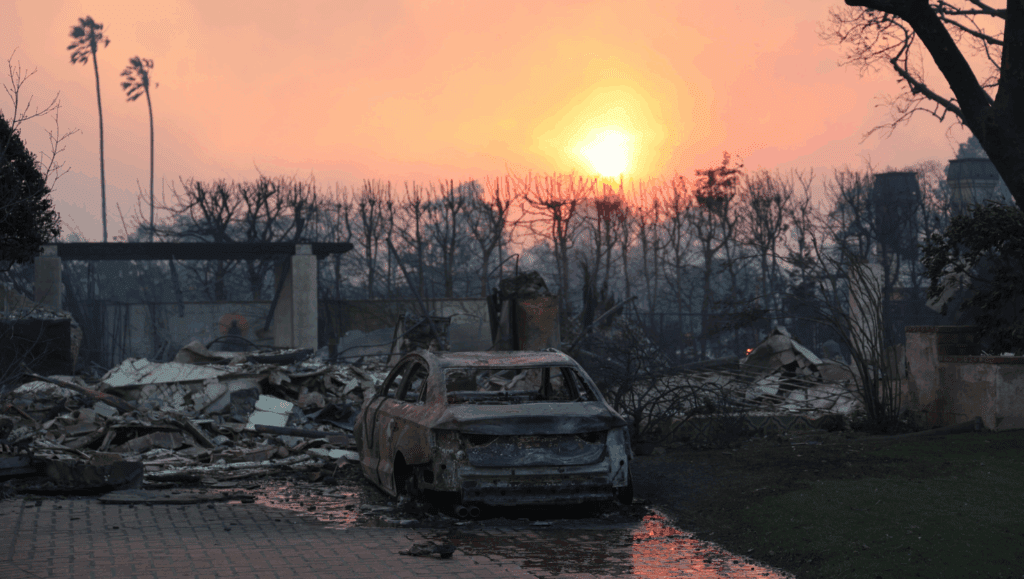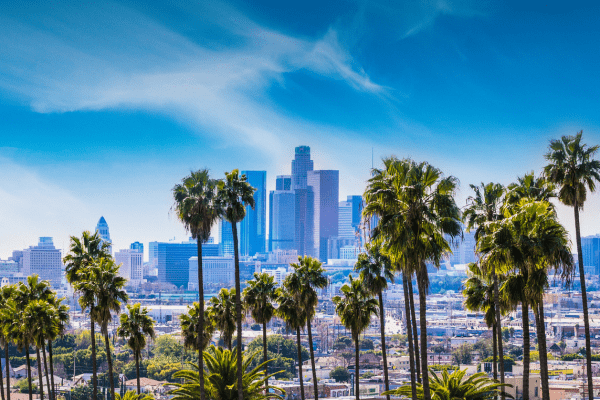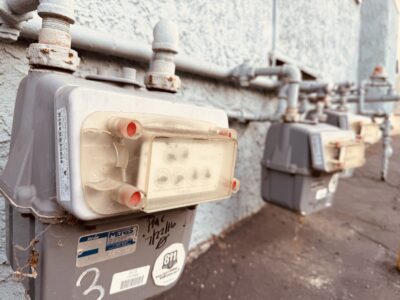What Went Wrong with News Coverage of the LA Fires
The Drain is a weekly roundup of environmental and climate news from Legal Planet.

When disaster strikes your town, you rely on journalists to help explain what happened and why.
Last January, many of us in Los Angeles turned to The LA Times as unusual firestorms kicked up and ultimately destroyed parts of Altadena and Pacific Palisades. The LAT’s journalists and photojournalists did incredible coverage from lots of angles, and the paper did a public service by dropping its paywall.
But there was also a problem: Very few of the stories, videos, investigative reports, and columns in The Los Angeles Times in the months that followed made any mention of climate change. I know because I counted.
A student researcher and I surveyed 610 LA Times stories from January and February and found that only 14% of stories included a mention of “climate change” or “global warming” during those two months — 13.9% in January and 15.2% in February. That’s a pretty low percentage given that there’s strong scientific consensus that human-caused climate change is one factor driving California’s increasingly intense and long fire season. If you want to know more, please read the whole report here. I explain the methodology in greater detail, breakdown differences between sections of the paper, describe why this can happen, and mention some possible solutions. I also write that this is an industry-wide problem, especially TV news.

So, why does this matter? For one thing: accuracy, plain and simple. Secondly, the LAT remains a regional leader in breaking news, especially wildfire coverage, that other outlets follow. And it’s influential with lawmakers — some still read the paper version every day. There’s a growing trend of climate silence in mainstream journalism — and now among philanthropists like Bill Gates (more on that below.)
We often say news is the first version of history. When journalists don’t connect the dots between extreme weather disasters and climate change, it sets a narrative for the months and years ahead when residents, policymakers, and elected officials will debate what went wrong and how to prevent it. As I told Sammy Roth for a writeup of our survey this week in his excellent newsletter Climate-Colored Goggles:
“If you were reading The LA Times in the aftermath of the fires, it would be easy to conclude that these firestorms were the fault of an arsonist, or a fire chief who didn’t send fire trucks to the right location, or a mayor who wasn’t in town, or an empty reservoir — you’ve got all these players… And the truth is that several factors made these urban fires explode, and made them as deadly as they were. And climate change is one of those factors. And to leave climate change off the list is to leave one of the culprits off the list.”
California communities and policymakers have done a lot of soul-searching about those other factors — but not how human-caused climate change contributed to this disaster. Stronger media coverage is just one lever to try to change that. I think of this survey as one ‘After Action Report’ for local journalism. Because this is the time for editors and newsroom leaders to think hard about the strength and weakness of their coverage — not in the middle of the next climate-fueled disaster, which is no doubt coming for us.
Welcome to The Drain, a weekly roundup of environmental and climate news. Our song of the week is “Not Strong Enough,” by Boygenius. Speaking of the next climate-fueled disaster…
Disasters
Hurricane Melissa made landfall over Jamaica as one of the strongest Category 5 storms on record, as a result of its rapid intensification, and there are early reports of massive destruction to infrastructure. Why yes, climate factors do make Jamaica especially vulnerable to this type of storm, Sachi Kitajima Mulkey writes for the NYT. And Hurricane Melissa has again raised the question of whether there is now a Category 6.
$101 Billion dollars: Climate Central is up and running with its version of a comprehensive database tracking U.S. weather and climate disasters since 1980 where overall damages/costs reached or exceeded $1 billion – since the Trump administration is no longer having the federal government do so.
And surprise! The data show that the first half of 2025 was the costliest on record for major disasters in the US, driven by huge wildfires in Los Angeles and storms that battered much of the rest of the country, Oliver Milman reports for the Guardian.
Understanding wildfire recovery is critical for when the next disaster follows — which is why Jeva Lange at Heatmap News set out to explore the topic in depth in a series called The Aftermath.
Drought and other climate shocks once seen as exceptional are now straining local budgets, Tik Root reports at Grist. “Droughts in at least 43 states, from Vermont to California, affecting 125 million people.”
Ten years ago this week, the Aliso Canyon facility near Porter Ranch spewed about 120,000 tons of methane and toxic chemicals, becoming the worst natural gas blowout in US history. What have we learned? Hayley Smith checked in on residents and regulators for the LA Times.
UN and COP30

The COP30 climate conference in Belém is “facing perhaps the biggest political pushback since negotiations started 30 years ago, with the Trump administration openly working to undermine measures…” writes Sara Schonardt at Politico. Fewer than 70 nations, out of 195, have offered up their new climate targets.
The fifth “State of Climate Action” finds that climate action across all sectors has “failed to materialize at the pace and scale required to achieve the Paris Agreement’s temperature goal. The report is published under Systems Change Lab. “None of the 45 indicators assessed are on track to reach their 1.5°C-aligned targets by the end of this decade,” the authors write.
Analysis by the UNFCCC itself suggests that if countries’ plans are carried out, the yearly amount of planet-warming gases added to the atmosphere would decrease 10% by 2035, from 2019 levels. “Far short of the 60% emissions drop needed by 2035 to limit global warming at 1.5 degrees Celsius above pre-industrial temperatures,” Kate Abnett at Reuters notes.
More than 150 countries signed on to a pledge to cut global methane emissions by 30% by 2030. They are moving too slow to achieve those goals, according to UNEP’s 2025 edition of its An Eye on Methane report.
“Less than a fifth of participating companies are currently reporting their emissions with what the U.N. considers “gold standard” measurements. Another 15 percent are on track to doing so within a few years, according to the NYT’s coverage of the report. Almost 90% of satellite-detected methane leaks flagged to governments and oil and gas companies are not being acknowledged, according to Reuters coverage of the report.
Gov. Gavin Newsom was announced as co-chair of the COP30 Local Leaders Forum. Co-chairs serve as mobilizing leaders — strengthening collaboration and showcasing a shared commitment towards climate targets. The forum will convene in Rio de Janeiro, Brazil, ahead of the COP30 negotiations in Belém in November.
Two of my Emmett Institute colleagues, Cara Horowitz and Jason Gray, will be on the ground for COP30 and shared some of their thoughts here. Journalists covering the conference: feel free to reach out ahead of time to talk with them about their observations and predictions.
Climate Politics
Philanthropist billionaire Bill Gates is generously sharing his thoughts on climate politics ahead of COP30, and everyone has a take.
The AP sums up Gates’ proposition as “a ‘strategic pivot’ in the global climate fight: from focusing on limiting rising temperatures to fighting poverty and preventing disease. The NYT writes that by “changing his tune,” Gates is reorienting his philanthropic dollars away from climate change and toward global aid. What has shifted here is “the global political environment,” Rob Meyer writes in a summary. But emerging scenes of devastated Jamaica may underline that fighting climate change and fighting disease or poverty should go hand in hand?
The Sierra Club has been on a campaign to boost the Club’s tiny membership in majority-Latino South San Diego County. Voice of San Diego covers that effort. “Statewide, the Club’s membership has declined by nearly a fifth since 2019” Jim Hinch writes. “During that same period, the San Diego chapter lost roughly 2,000 members. Just 1,200 of the chapter’s current 13,000 members live in South San Diego County.”
Senate candidate in Michigan Abdul El-Sayed talks with Drilled’s Carbon Bros podcast about what Democrats are getting wrong when it comes to appealing to young men, and how to redirect young men’s anger towards the polluters actually making their lives worse.
Energy
Trump named Republican Laura Swett as the new head of the Federal Energy Regulatory Commission, the agency announced Friday.
The Texas boom in data center construction is being powered primarily with new wind, solar, and batteries, according to new analysis by the Energy Information Administration. That’s not been the case elsewhere.
DOE Secretary Chris Wright urged FERC to assert jurisdiction over “large loads” that link directly to interstate transmission, in a letter released Friday. “It’s Trump officials’ most direct move yet to smooth the bureaucratic path for AI data centers — and power sources serving them — to come online,” Axios’ Ben Geman writes.
Can data centers be incentivized to think battery-first? Aligned Data Centers will pay to build a 31-megawatt battery, an early example of how AI developers can move fast if they’re willing to be flexible, Julian Spector reports at Canary Media.
Tech giant Amazon talked about concealing the true extent of its data center’s water use, a leaked internal document obtained by the Guardian’s Luke Barratt and Rosa Furneaux reveals.
Offshore wind developers, which were slow to fight back against Trump administration attacks, are now trying another tactic of hiring lobbyists with ties to Trump (like David Bernhardt) to help stave off stop-work orders, E&E’s Benjamin Storrow reports. But RFK Jr. has ordered the much-weakened CDC to study alleged health harms of wind turbines.
Sen. Sheldon Whitehouse threatened to blow up any permitting reform from his perch at Environment and Public Works Committee if the White House keeps attacking wind and solar energy projects.
Austria’s power corridors have been getting a whimsical update: The Austrian Power Giants concept, recently honored by the Red Dot Design Award, swaps boring pylon shapes for animal-inspired silhouettes.
With California inching toward the creation of an independent regional organization to oversee Western energy markets, here are 3 things it should learn from mistakes made in other regions, writes my Emmett Institute colleague Elias Van Emmerick.
California

Which is better: LADWP or Southern California Edison? My UCLA Emmett Institute colleague Denise Grab wrote a new paper that examines that question from the standpoint of cost to ratepayers and climate goals. Turns out the gap between investor-owned and public utilities is narrowing.
And how democratic is your water utility? New UC research in the journal Nature Water suggests that those with elected leaders perform better, LAT’s Ian James reports.
The DWP board voted this week to nearly double the amount of water it recycles for drinking at a wastewater treatment plant in Van Nuys, Erin Stone reports for LAist. “Officials and supporters of the project say the expansion also can help restore water levels in Mono Lake in the eastern Sierra.”
Come December, the country’s first all-electric hospital will open in Irvine. UCI Medical Center will be powered by SCE, LAist reports.
Air quality regulators at the California Air Resources Board said last week that they plan to develop new vehicle emission rules by summer 2027 as they respond to the Trump administration’s rollback of the state’s electric vehicle sales mandate, Alex Nieves reports for Politico.
And EVs for All America, run by former Republican strategist Mike Murphy, is making a play for the California Legislature to invest in building out EV charging infrastructure in multi-family condos and apartments, Nieves reports.
Fire safety advocates like Michael Wara at Stanford are disappointed with Gov. Newsom’s recent veto of SB 326. That bill would have pushed up timelines for clearing shrubs and brush around some California homes, and would have required comprehensive planning and fire modeling, KQED reports.
A year after four dams were removed along the California-Oregon border, salmon have reached the Klamath River’s headwaters for the first time in more than a century, reports Kurtis Alexander for the SF Chronicle. “It’s a true blessing,” said William Ray Jr., chair of the Klamath Tribe.
My UCLA Law colleague Ann Carlson will join former CARB chief counsel Ellen Peter and others for a Coalition for Clean Air webinar, “Waivers in Flux” on Nov. 6.
Trump administration
The Trump administration announced its plan to allow oil and gas drilling in Alaska’s pristine Arctic National Wildlife Refuge. And though it hasn’t announced it, the administration also is readying a proposal to open almost all US coastal waters to new offshore oil drilling, according to Jennifer A. Dlouhy at Bloomberg based on documents detailing the expansive Interior Department proposal.
The Houston Chronicle first reported that the plans would try to allow offshore oil drilling along the California coast and along the East Coast for the first time since the 1980s, but “retain a ban on drilling off of Florida.”
Democrat and Republican members of Congress from Maine to Florida oppose the plan.
Meanwhile, oil companies themselves are warning the administration not to cancel the Greenhouse Gas Reporting Program. Halting emissions reporting introduces “significant uncertainty for producers” and “unnecessary complexity into programs that are critical for deploying the very solutions needed to meet energy and climate goals,” one industry trade group spokesman said in public testimony at an EPA hearing on the proposal.
In the shutdown department: U.S. District Judge Susan Illston in San Francisco has indefinitely barred the Trump administration from firing federal employees during the government shutdown because labor unions were likely to prevail on their claims that the cuts were arbitrary and politically motivated.
And contrary to what Trump says at rallies and to the UN General Assembly, he knows climate change is real and “he’s banking on it” writes USC Annenberg’s Allison Agsten, pointing to the administration’s desire to mine in Greenland.
Courts & Litigation
Exxon Mobil has filed suit in federal court citing 1st Amendment grounds challenging California’s 2 climate disclosure laws that would require thousands of large companies like Exxon to report the greenhouse emissions resulting from the use of its products globally, report LAT’s Suzanne Rust and Doug Smith. SB 253 and 261 “compel Exxon Mobil to trumpet California’s preferred message,” the oil giant argues. Gov. Newsom’s office shot back that it was shocking the company would be “opposed to transparency.”
The argument for ecocide law is simple, my UCLA Law colleague Kate Mcintosh writes at Icarus Complex in an article about international law catching up to the realization that human well-being and the natural world are inseparably linked. “The gravest forms of environmental destruction are also grave violations of human rights, and international law must evolve to reflect that truth.”
Survivors of Typhoon Rai are suing Shell in the UK courts for the company’s role, the Guardian reports. The typhoon was the strongest storm to hit the Philippines in 2021, killing more than 400 people, displacing nearly 3.2 million and destroying more than 1 million homes from island communities in the Philippines.
And a judge ordered New York Governor Kathy Hochul’s administration to issue rules for its long-delayed cap-and-invest program by February, the Albany Times-Union reports.
Climate Interventions
Stardust Solutions, a US company led by a team of Israeli physicists, announced Friday that it has raised $60 million in venture capital to develop technological building blocks that it says will make solar geoengineering possible by the beginning of next decade, Robinson Meyer reports at Heatmap News.
There are interesting survey findings of climate scientists about solar geoengineering here:
- 66% believe we will see it attempted this century
- 52% say it will probably be done by a “rogue actor”
- 81% want an international treaty to manage risk
Media News

A new UC Santa Barbara study finds that watching 3-5 minutes of inspiring content about underdog characters succeeding at something each day can help increase hopefulness and decrease stress… Maybe that’s why I loved seeing this LA Taco story on Los Angeles bartender extraordinaire Matthew Biancaniello swim 21 miles from Catalina Island to LA. For 18 hours. Much of it in pitch black darkness.
Consumer Watchdog launched a podcast called Smoke & Mirrors that investigates the insurance industry’s treatment of policyholders in Altadena and Palisades after the January fires.
The Arizona Republic’s climate reporter Joan Meiners is biking the 850-mile Arizona Trail to investigate how climate change is impacting the state. You can follow her journey.
Elon Musk launched (I’m so sorry) “Grokipedia,” a crowdsourced online encyclopedia that the billionaire seeks to position as a rival to Wikipedia, which he deems too woke. APM’s Marketplace tried asking both about climate change and found Grokipedia’s to be inaccurate.
Here’s a good palate cleanser: In the latest edition of Project Drawdown’s video series Drawdown’s Neighborhood, they share the stories of seven climate changemakers from Los Angeles, including staff of Heal the Bay and Crop Swap LA.







Re EVs and multifam buildings – are we sure that it wouldn’t be a better idea to try to get car mfs to share battery types?
What about those scary battery fires that no one can put out?
I feel that I’d like to know more!